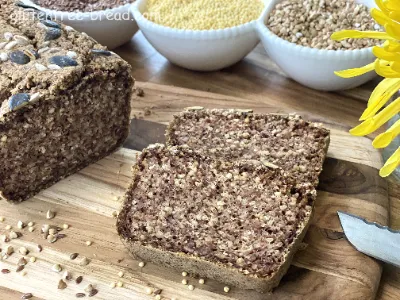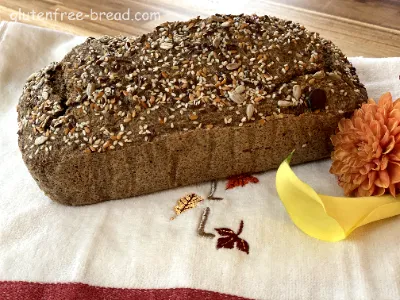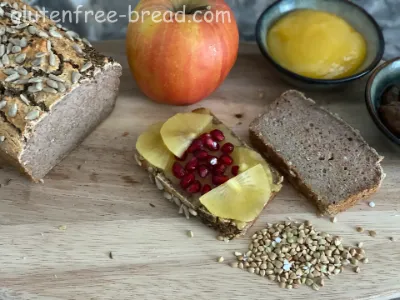Additional info
Gluten-free buckwheat flour bread is a type of bread made without the use of wheat or other gluten-containing grains. Buckwheat, despite its name, is not related to wheat and is naturally gluten-free. Here are some characteristics and aspects of gluten-free buckwheat flour bread:
Ingredients
- Buckwheat Flour: The primary ingredient, giving the bread its distinctive flavor and nutritional profile.
- Binding Agents: Since gluten is absent, binding agents like xanthan gum, psyllium husk, or flaxseed meal are often added to provide structure and elasticity.
- Leavening Agents: Yeast or baking powder to help the bread rise.
- Liquid Ingredients: Water, milk (dairy or non-dairy), and sometimes apple cider vinegar or lemon juice to activate the leavening agents.
- Sweeteners: Optional ingredients like honey, maple syrup, or sugar for added flavor.
- Fats: Oils or butter to add moisture and richness.
Texture
- Buckwheat flour bread tends to be denser than traditional wheat bread due to the absence of gluten.
- It may have a slightly crumbly texture, although binding agents help create a more cohesive structure.
Flavor
- Buckwheat has a unique, robust, nutty flavor that sets it apart from other gluten-free flours.
- The bread can have a slightly earthy taste, which pairs well with both sweet and savory toppings.
Nutritional Benefits
- High in Fiber: Buckwheat is rich in dietary fiber, aiding digestion.
- Rich in Protein: Contains all eight essential amino acids.
- Minerals and Vitamins: High in magnesium, copper, and manganese, and contains various B vitamins.
- Antioxidants: Buckwheat is known for its antioxidant properties, which can help reduce inflammation and support overall health.
Uses
- Sandwiches: Suitable for making sandwiches, though it may be best toasted to improve texture.
- Toast: Excellent for toasting and topping with butter, avocado, nut butters, or jam.
- Accompaniment: Works well as a side to soups, stews, or salads.
Baking Tips
- Mixing Flours: Often combined with other gluten-free flours like rice flour, tapioca flour, or almond flour to improve texture.
- Hydration: Buckwheat flour absorbs more liquid than wheat flour, so recipes may require adjustments in liquid quantities.
- Resting Time: Allowing the batter to rest before baking can improve the texture of the final product.
Overall, gluten-free buckwheat flour bread is a nutritious and flavorful alternative to traditional wheat bread, suitable for those with gluten intolerance or celiac disease, and anyone looking to try a different type of bread.











